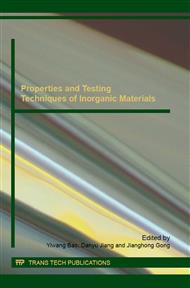[1]
P. Wang, Solid-state thermolysis of ammonia borane and related materials for high-capacity hydrogen storage, Dalton Trans. 15 (2012) 4296-4302.
DOI: 10.1039/c2dt11778a
Google Scholar
[2]
J. Zhang, J.W. Lee, Progress and prospects in thermolytic dehydrogenation of ammonia borane for mobile applications, Korean Journal of Chemical Engineering. 29(2012) 421-431.
DOI: 10.1007/s11814-012-0032-1
Google Scholar
[3]
H.T. Hwang, A. Al-Kukhun, A. Varma, High and rapid hydrogen release from thermolysis of ammonia borane near PEM fuel cell operating temperatures, Fuel & Energy Abstracts, 37(2012) 2407–2411.
DOI: 10.1016/j.ijhydene.2011.10.088
Google Scholar
[4]
B.D. Solomon, A. Banerjee, A global survey of hydrogen energy research, development and policy, Energy Policy, 34 (2006) 781-792.
DOI: 10.1016/j.enpol.2004.08.007
Google Scholar
[5]
X. Chen, X. Bao, B. Billet, et al. Large-Scale and Facile Preparation of Pure Ammonia Borane through Displacement Reactions, Chemistry-A European Journal, 18 (2012) 11994–11999.
DOI: 10.1002/chem.201201342
Google Scholar
[6]
L. Schlapbach, A. Zuttel, Hydrogen-storage materials for mobile applications, Nature. 414 (2001) 353-358.
DOI: 10.1038/35104634
Google Scholar
[7]
D. Kumar, H.A. Mangalvedekar, S.K. Mahajan, Dehydrogenation of Ammonia Borane with catalytic thermal decomposition, International Journal of Advancements in Research & Technology. 7(2013)478-483.
Google Scholar
[8]
U. Eberle, M. Felderhoff, F. Schüth, Chemical and Physical Solutions for Hydrogen Storage, Angewandte Chemie International Edition. 48 (2009) 6608–6630.
DOI: 10.1002/anie.200806293
Google Scholar
[9]
P.V. Ramachandran, P.D. Gagare, Preparation of ammonia borane in high yield and purity methanolysis and regeneration, Inorganic Chemistry. 46 (2007) 7810-7817.
DOI: 10.1021/ic700772a
Google Scholar
[10]
P.V. Ramachandran, H. Mistry, A.S. Kulkarni, et al. Ammonia-mediated, large-scale synthesis of ammonia borane, Dalton Transactions, 2014, 43: Advance Article.
DOI: 10.1039/c4dt02467b
Google Scholar
[11]
Q. Xu, M. Chandra, A portable hydrogen generation system: Catalytic hydrolysis of ammonia–borane, Journal of Alloys & Compounds. 446 (2007)729–732.
DOI: 10.1016/j.jallcom.2007.01.040
Google Scholar
[12]
R.P. Shrestha, H.V.K. Diyabalanage, T.A. Semelsberger, et al. Catalytic dehydrogenation of ammonia borane in non-aqueous medium, International Journal of Hydrogen Energy. 34 (2009) 2616–2621.
DOI: 10.1016/j.ijhydene.2009.01.014
Google Scholar
[13]
A. Gutowska, L.Y. Li, Y.S. shin, et al. Nanoscaffold mediates hydrogen release and the reactivity of ammonia borane, Angewandte Chemie International Edition. 44 (2005) 3578–3582.
DOI: 10.1002/anie.200462602
Google Scholar
[14]
D.J. Heldebrant, A. Karkamkar, N.J. Hess, et al. The Effects of Chemical Additives on the Induction Phase in Solid-State Thermal Decomposition of Ammonia Borane, Chemistry of Materials. 20 (2008) 5332-5336.
DOI: 10.1021/cm801253u
Google Scholar
[15]
D.W. Himmelberger, C.W. Yoon, M.E. Bluhm, et al. Base-promoted ammonia borane hydrogen-release, Journal of the American Chemical Society, 2009, 131.
DOI: 10.1021/ja905015x
Google Scholar
[16]
M.E. Bluhm, M.G. Bradly, R. Butterrick, et al. Amineborane-based chemical hydrogen storage: enhanced ammonia borane dehydrogenation in ionic liquids, Journal of the American Chemical Society, 2006, 128.
DOI: 10.1021/ja062085v
Google Scholar
[17]
A. Al-Kukhun, H.T. Hwang, A. Varma, A comparison of ammonia borane dehydrogenation methods for proton exchange-membrane fuel cell vehicles: hydrogen yield and ammonia formation and its removal, Ind Eng Chem Res. 50 (2011)8824-35.
DOI: 10.1021/ie102157v
Google Scholar
[18]
H.T. Hwang, A. Varma, Effect of boric acid on thermal dehydrogenation of ammonia borane: Mechanistic studies, International Journal of Hydrogen Energy, 38 (2013)1925–(1931).
DOI: 10.1016/j.ijhydene.2012.11.046
Google Scholar
[19]
R. Xiong, J. Zhang, Y. Zhao, et al. Rapid release of 1. 5 equivalents of hydrogen from CO2 -treated ammonia borane, International Journal of Hydrogen Energy. 37 (2012)3344–3349.
DOI: 10.1016/j.ijhydene.2011.11.049
Google Scholar


